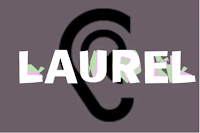Basically, people hear different words from the same recording depending on which frequency they are most attuned to. Yesterday afternoon I heard “Yanny.” This morning I’m hearing “Laurel.” Maybe that means my hearing changes during the day, or maybe it is temperature driven.
At any rate, there are lots of explanations on the Internet right now. Steven Pinker summarized it this way:
The illusion teaches much about perception: Sensory input is ambiguous; brain groups elements into coherent guess about worldly source; locks onto guess, perceives elements accordingly. 1st guess may be arbitrary; futile to explain why people differ.
Here’s one what allows you to hear both words: https://www.vox.com/science-and-health/2018/5/16/17360332/yanny-laurel-audio-science-explained-nature-of-reality
_____
How does this relate to the Book of Mormon?
We have faithful members of the Church looking at exactly the same evidence and reading exactly the same scriptures yet reaching different conclusions about the geography, anthropology, archaeology, etc.
Here’s a comparison table. See which version of the evidence you “hear” as you go through the list.
|
Proposition
|
Agree
|
Disagree
|
|
1. When Moroni first visited Joseph Smith, he said the record was “written and deposited” not far from Joseph’s home. (Letter IV)
|
||
|
2. Joseph Smith obtained the original set of plates from a stone box Moroni constructed out of stone and cement in the Hill Cumorah in New York.
|
||
|
3. Mormon said he buried all the Nephite records in the Hill Cumorah (Morm. 6:6), which was the scene of the final battles of the Nephites, except for the plates he gave to his son Moroni to finish the record.
|
||
|
4. Orson Pratt explained that Moroni deposited the plates in “a department of the hill separate from the great, sacred depository of the numerous volumes hid up by his father.”
|
||
|
5. Brigham Young said Oliver told him that he (Oliver) and Joseph had made at least two visits to a room in the Hill Cumorah in New York that contained piles of records and ancient Nephite artifacts.
|
||
|
6. Heber C. Kimball talked about Father Smith, Oliver Cowdery, and others seeing records upon records piled upon tables in the hill Cumorah.
|
||
|
7. When Joseph and Oliver finished translating the original set of plates in Harmony, PA, Joseph gave the plates to a divine messenger who took them to Cumorah.
|
||
|
8. In Fayette, NY, Joseph and Oliver translated the plates of Nephi.
|
||
|
9. Oliver Cowdery said it was a fact that the valley west of the Hill Cumorah in New York was the location of the final battles of the Nephites and Jaredites (Letter VII).
|
||
|
10. Joseph Smith had his scribes to copy Oliver’s letters, including Letter VII, into his journal as part of his history.
|
||
|
11. Joseph Smith gave express permission to Benjamin Winchester to republish Oliver’s letters, including Letter VII, in his 1841 newspaper called the Gospel Reflector.
|
||
|
12. Joseph Smith gave Don Carlos Oliver’s letters, including Letter VII, to republish in the Church newspaper called the Times and Seasons (T&S) in 1840-41.
|
||
|
13. Letter VII was republished in the Millennial Star and the Improvement Era and in an 1844 pamphlet in England.
|
||
|
14. D&C 128:20 reads, “And again, what do we hear? Glad tidings from Cumorah! Moroni, an angel from heaven, declaring the fulfilment of the prophets—the book to be revealed,” followed by references to other events that took place in New York.
|
||
|
15. To date, apart from Moroni’s stone box and the plates and other objects Joseph Smith possessed and showed to the Witnesses, no artifact or archaeological site that can be directly linked to the Book of Mormon has been found anywhere.
|
||
|
16. Every LDS who was alive during Joseph Smith’s lifetime, and several prophets and apostles since, accepted the New York hill Cumorah as the scene of the final battles, including in General Conference addresses. No General Conference address has ever claimed Cumorah was anywhere but in New York.
|
||
|
17. As an Apostle and Church Historian, Joseph Fielding Smith said the two-Cumorah theory caused members to become confused and disturbed in their faith in the Book of Mormon. He reiterated this when he was President of the Quorum of the Twelve in the 1950s in his book Doctrines of Salvation.
|
||
|
18. Joseph Smith and Oliver Cowdery were merely speculating about the location of Cumorah. They were wrong and they misled the Church.
|
||
|
19. Joseph Fielding Smith was wrong when he criticized the two-Cumorahs theory and maintained that Cumorah is in New York.
|
||
|
20. Anthony Ivins, Marion G. Romney, and Mark E. Peterson were all wrong when they spoke in General Conference about Cumorah being in New York.
|
Score:
Source: Book of Mormon Wars
